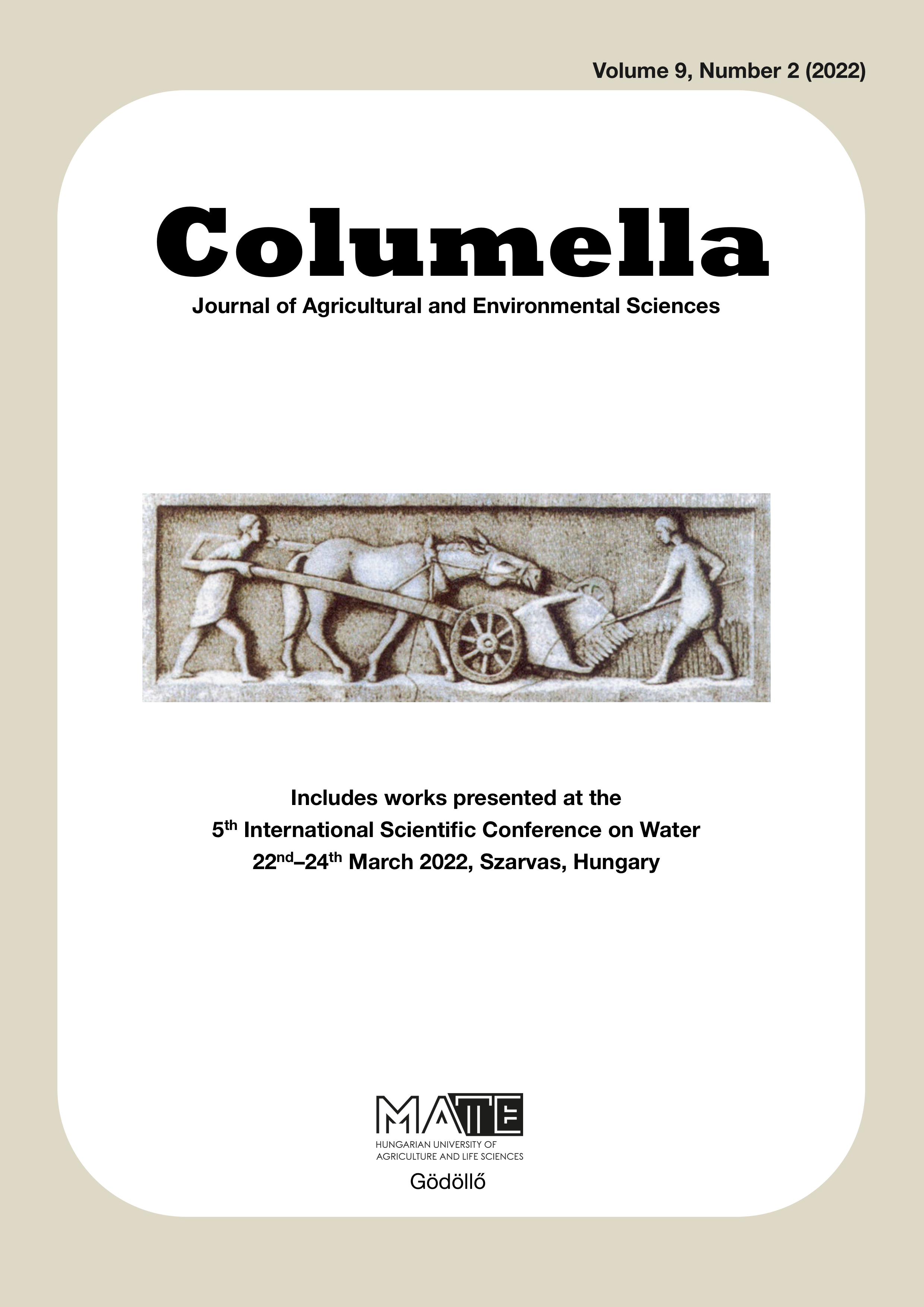Effect of precipitation on the nutrient reaction of triticale varieties
DOI:
https://doi.org/10.18380/SZIE.COLUM.2022.9.2.167Keywords:
triticale, variety, nutrient supply, climatic condition, yieldAbstract
Triticale is the first man made genus hybrid of wheat and rye. The basic aim of its production was to combine yield potential and grain quality of wheat with the disease and environmental tolerance of rye. In the past decades, triticale crop area has been increasing in Hungary, which climate change has also contributed. The triticale is produce well in dry climatic conditions, so it becomes more and more popular among farmers. Our country is the one of the top 10 triticale producing countries in the World. In the long-term fertilization experiment, at Fülöpszállás, on calcic meadow chernozem soil we carried out experiments in three growing seasons (2018/2019, 2019/2020, 2020/2021) with three winter triticale varieties (Hungaro, Mv Talentum, GK Maros,) in 4 replications, on 20 square meter random layout plots. In our experiment, we examined 15 different fertilization treatments, in every year, which can be used as different fertilization strategies. From the results of our experiments, we concluded that the yield of triticale is largely determined by genotype and nutrient supply, which is strongly influenced by the average annual precipitation. In the dry year, the effect of nutrients on yield was greater than in the rainy growing season.
References
Abdelaal, H., Bugaev, P., & Fomina, T. (2019). Nitrogen fertilization effect on grain yield and quality of spring triticale varieties. Indian Journal of Agricultural Research 53(5), 578-583. doi: https://doi.org/10.18805/IJARe.A-426
Arseniuk, E. (2014). Triticale biotic stresses–an overview. Commun Agric Appl Biol Sci 79(4), 82-100.
Bóna, L., Aadanyi, N., Daood, H. G., Farka, R., Szabó, E., Hajós, G., . . . Purnhauser, I. (2006). Antioxidants in triticale grains. In W. C. Botes (Ed.), 6th international triticale symposium (p. 114- 118). Stellenbosch University Press.
Bona, L., Acs, E., Lantos, C., Tomoskozi, S., & Lango, B. (2014). Human utilization of triti- cale: technological and nutritional aspects. Communications in Agricultural and Applied Biological Sciences 79(4), 139-152.
Cooper, K. V. (1985). The Australian triticale cookery book. Adelaide: Savvas Publishing.
Darvey, N. L., Naeem, H., & Gustafson, J. P. (2000). Triticale: Production and Utilization. In K. Kulp (Ed.), Handbook of Cereal Science and Technology. Boca Raton: CRC Press.
Demirbas, A. (2007). Progress and recent trends in biofuels. Progress in Energy and Combustion Science 33(1), 1-18. doi: https://doi.org/10.1016/j.pecs.2006.06.001
Dennett, A. L., Schofield, P. R., Roake, J. E., Howes, N. K., & Chin, J. (2009). Starch swelling power and amylose content of triticale and Triticum timopheevii germplasm. Journal of Cereal Science 49(3), 393-397. doi: https://doi.org/10.1016/j.jcs.2009.01.005
Erekul, O., & Köhn, W. (2006). Effect of weather and soil conditions on yield components and bread-making quality of winter wheat (triticum aestivum l.) and winter triticale (triticosecale wittm.) varieties in north-east germany. Journal of Agronomy and Crop Science 192(6), 452-464. doi: https://doi.org/10.1111/j.1439-037X.2006.00234.x
FAO. (2020). Crops and livestock products. Retrieved 2022.12.17., from www.fao.org/faostat/ en/#data/QCL
Fraś, A., Gołębiewska, K., Gołębiewski, D., Mańkowski, D. R., Boros, D., & Szecówka, P. (2016). Variability in the chemical composition of triticale grain, flour and bread. Journal of Cereal Science 71(1), 66-72. doi: https://doi.org/10.1016/j.jcs.2016.06.016
Gill, K. S., & Omokanye, A. T. (2016). Spring Triticale Varieties Forage Yield, Nutrients Composition and Suitability for Beef Cattle Production. Journal of Agricultural Science 8(10), 1. doi: https://doi.org/10.5539/jas.v8n10p1
Habib-ur-Rahman, M., Raza, A., Ahrends, H. E., Hüging, H., & Gaiser, T. (2021). Impact of in-field soil heterogeneity on biomass and yield of winter triticale in an intensively cropped hummocky landscape under temperate climate conditions. Precision Agriculture 23(3), 912-938. doi: https://doi.org/10.1007/s11119-021-09868-x
Hajós, G. (2008). Élelmiszer-kémia. Budapest: Akadémiai Kiadó.
Heger, J., & Eggum, B. (1991). The nutritional values of some high-yielding cultivars of triticale. Journal of Cereal Science 14(1), 63-71. doi: https://doi.org/10.1016/S0733-5210(09)80018 -0
Kádár, I., Németh, T., & Szemes, I. (1999). Tritikále trágyareakciója a nyírlugosi tartamkísérletben. Növénytermelés 48(6), 647-661.
Kruppa, J. (2004). Tritikálé. In Z. Izsáki & L. Lázár (Eds.), Szántóföldi növények vetőmagtermesztése és kereskedelme. Budapest: Mezőgazda Kiadó.
Kruppa, J., Pepó, P., & Győri, Z. (1999). A triticale mino ̋ségi tulajdonságai és hasznosítási lehetőségei. Mag, Kutatás, Termesztés, Kereskedelem 13(5), 12-14.
Márton, L. (2002a). A csapadék-és a tápanyagellátottság hatásának vizsgálata a triticale termésére tartamkísérletben. Növénytermelés 51(6), 687-701.
Márton, L. (2002b). Csapadék, tápanyagellátás és az őszi búza (Triticum aestivum L.) termése közötti kapcsolat. Növénytermelés 51(5), 529-542.
Márton, L. (2008). Long-term study of precipitation and fertilization interactions on winter wheat (Triticum aestivum L.) yield in the Nyírlugos Field Trial in Hungary between 1973 and 1990. Cereal Research Communications 36(3), 511–522. doi: https://doi.org/10.1556/crc.36.2008.3.15
McGoverin, C. M., Snyders, F., Muller, N., Botes, W., Fox, G., & Manley, M. (2011). A review of triticale uses and the effect of growth environment on grain quality. Journal of the Science of Food and Agriculture 91(7), 1155-1165. doi: https://doi.org/10.1002/jsfa.4338
Radics, L., & Pusztai, P. (2011). Alternatív növények korszerű termesztése. Budapest: Szaktudás Kiadó.
Randhawa, H. S., Bona, L., & Graf, R. J. (2015). Triticale Breeding—Progress and Prospect. In F. Eudes (Ed.), Triticale (p. 15-32). Springer International Publishing. doi: https://doi.org/10.1007/978-3-319-22551-7_2
Stace, C. A. (1987). Triticale: A case of nomenclatural mistreatment. Taxon 36(2), 445-452. doi: https://doi.org/10.2307/1221447
Wos ́,H.,&Brzezin ́ski,W. (2015). TriticaleforFood—TheQualityDriver. InF.Eudes (Ed.), Triticale (p. 213-232). Springer International Publishing. doi: https://doi.org/10.1007/978-3-319-22551-7_11
Wrigley, C., & Bushuk, W. (2017). Triticale: Grain-Quality Characteristics and Management of Quality Requirements. In C. Wrigley, I. Batey, & D. Miskelly (Eds.), Cereal grains (second edition) (Second Edition ed., p. 179-194). Woodhead Publishing. doi: https://doi.org/10.1016/B978-0-08-100719-8.00008-5
Downloads
Published
Issue
Section
License
Copyright (c) 2022 István Kristó, Marianna Vályi-Nagy, Attila Rácz, Melinda Tar, Katalin Irmes

This work is licensed under a Creative Commons Attribution-NonCommercial-NoDerivatives 4.0 International License.






